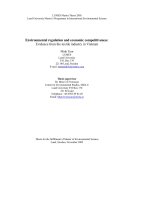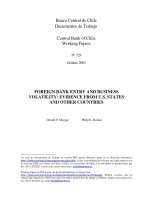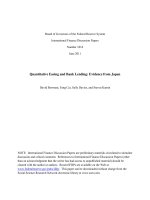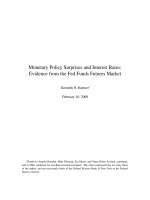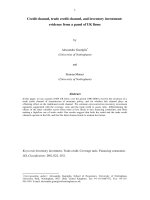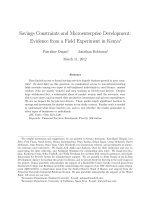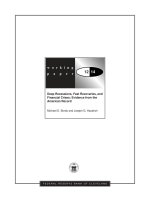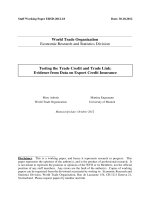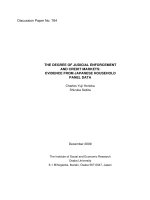FDI and income inequality evidence from panel data of vietnams provinces
Bạn đang xem bản rút gọn của tài liệu. Xem và tải ngay bản đầy đủ của tài liệu tại đây (1.26 MB, 68 trang )
UNIVERSITY OF ECONOMICS
INSTITUTE OF SOCIAL STUDIES
HO CHI MINH CITY
THE HAGUE
VIETNAM
THE NETHERLANDS
VIETNAM - NETHERLANDS
PROGRAMME FOR M.A IN DEVELOPMENT ECONOMICS
FDI and Income Inequality:
Evidence from panel data of Vietnam’s provinces
BY
LAM VAN ROI
MASTER OF ARTS IN DEVELOPMENT ECONOMICS
HO CHI MINH CITY, December 2014
UNIVERSITY OF ECONOMICS
INSTITUTE OF SOCIAL STUDIES
HO CHI MINH CITY
THE HAGUE
VIETNAM
THE NETHERLANDS
VIETNAM - NETHERLANDS
PROGRAMME FOR M.A IN DEVELOPMENT ECONOMICS
FDI and Income Inequality:
Evidence from panel data of Vietnam’s provinces
A thesis submitted in partial fulfilment of the requirements for the degree of
MASTER OF ARTS IN DEVELOPMENT ECONOMICS
By
LAM VAN ROI
Academic Supervisor:
PHAM KHANH NAM
HO CHI MINH CITY, December 2014
ABSTRACT
DOES FDI AFFECT ON INCOME INEQUALITY?
This paper attempts to estimate GINI indices for all provinces of Vietnam and
contributes to explore the relationship between FDI and income inequality. The thesis
uses a balance panel data for 56 provinces in 5 years which includes GDP, FDI and
income distribution. The thesis found that there is no evidence impact of FDI to
income inequality.
2
Contents
Chapter 1: INTRODUCTION............................................................................................................. 3
1. Problem statements ...................................................................................................................... 3
2. Research objectives ...................................................................................................................... 5
3. Research Scope and data ............................................................................................................. 5
4. Organization of the thesis ............................................................................................................ 5
Chapter 2: LITERATURE REVIEWS .............................................................................................. 7
1. Theoretical backgrounds ............................................................................................................. 7
2. Empirical studies ........................................................................................................................ 10
Chapter 3: RESEARCH METHOLOGY ........................................................................................ 14
1. Data .............................................................................................................................................. 14
1.1 Gini Coefficient ..................................................................................................................... 14
1.2 Share of FDI in GDP ............................................................................................................ 15
1.3 Data summary....................................................................................................................... 15
2. Conceptual Framework: ............................................................................................................ 18
3. Model specification ..................................................................................................................... 18
Chapter 4: RESULTS OF ANALYSIS ON FDI AND INCOME INEQUALITY ........................ 23
1. Foreign Direct Investment in Vietnam – An overview ............................................................ 23
2. Income inequality in Vietnam ................................................................................................... 27
3. Descriptive statistics ................................................................................................................... 29
4. Regression results ....................................................................................................................... 32
Chapter 5: CONCLUSIONS AND POLICY RECOMENDATION ............................................. 37
1. Conclusions ................................................................................................................................. 37
2. Policy Recommendations ........................................................................................................... 38
3. Limitation of the thesis and suggestion of further research ................................................... 41
REFERENCES ................................................................................................................................... 42
APPENDIX ......................................................................................................................................... 46
A – DATA ON FDI AND GINI ..................................................................................................... 46
Table 1: Information detail for provinces ..................................................................................... 46
Table 2: Vietnam’s 10 leading FDI investors in 11 months of 2014............................................ 47
Table 3: Top 10 provinces in FDI attraction in 11 month of 2014 ............................................... 48
Table 4: 10 sectors attracting FDI head of VN in 9M-2014 ......................................................... 48
Table 5: Some facts about income distribution and inequality in Vietnam .................................. 49
B - DESRRIPTION OF THE DATASET .................................................................................... 49
Table 0: List of provinces and variables detail ............................................................................. 49
Table 6: Summary statistic of variables ....................................................................................... 60
Table 7.1: Results of Pool OLS .................................................................................................... 61
Table 7.2: Result run Random Effect Model ................................................................................ 61
Table 7.3: Result of Fixed Effect Model ...................................................................................... 62
Table 8: Result of Hausman Test ................................................................................................. 62
Table 9: Summary of two new regression for Fixed and Random Effect .................................... 63
C- Figure of endogeneity test and solution:.................................................................................. 64
Figure 1: IV estimator 2SLS......................................................................................................... 64
Figure 2: First-stage regression and instruments are weak test .................................................... 65
Figure 3: Endogeneity Test .......................................................................................................... 65
Figure 4: Regression for FDI stock in GDP by lagged of FDI stock in GDP .............................. 65
2
Chapter 1: INTRODUCTION
This chapter of the thesis will introduce the problem statement and research object
under the perspective of the social sciences . It stated why this thesis was formed for
the purpose of explaining the relationship between FDI and income inequality . This
chapter also presents the essential content and will be explained in detail in the next
chapter . In addition , the structure of the thesis is also stated in this chapter.
1. Problem statements
In recent years, Vietnam has made significant achievements in improving the
economy and society. The growth of economy is about 7% per year, GDP per capita
has increased and poverty ratio has reduced year by year (Mahajan et al., 2014). This
achievement is a positive signal for the transitional economy, and Vietnam also
changes many policies to follow up with the globalization trend. In 2009, Vietnam
was a member of Lower-middle income countries and became a success story.
Vietnam’s economic growth made poverty situation decreasing and improving
income inequality. Sustainable economic growth is an advantage to attract more FDI
from developed countries.
Opening economy in Vietnam, after Doi Moi Policy, is also like other developing
countries in improving environmental investment in order to attract more FDI from
the world. According to ASEAN Business Outlook Survey in 2012/2013, there were
over 50% of foreign investors wanted to expand their businesses in Vietnam, because
Vietnam has the political stability and a safety destination. That is the reason why FDI
has been increasing year by year.
The impact of FDI to Vietnam’s economy is very important because FDI entices the
growth rate, alleviate poverty and technology transition. However, FDI is often
unevenly distributed among provinces of Vietnam, so the impact of FDI to each
3
province is different from province to province. The understanding FDI is important
to make policy.
The empirical study about FDI in provinces of Vietnam focused on researching
impact of FDI to economic growth, employment generation and technology spillover
effect. Furthermore, the analysis of FDI in inequality has few studies and the most of
studies treats impact of FDI between countries in economic growth.
In addition, the role of FDI investment in the country as well as the provinces of the
country that generated a strong effect in attracting an abundant labor force of that
country where FDI decides to make an investment. Therefore, the creation of jobs for
the workforce in place that FDI will create the income distribution in the entire
region. The income distribution is uneven, and it depends greatly on the level of
technology, skilled labor, skills of the workforce in the environment. So therefore ,
the required skill level of the labor multinational companies appear and create a
greater pressure on the demand of high quality labor but high-quality labor supply in
the country has certain restrictions. This leads to large disparities in the distribution of
wages between skilled and unskilled manual workers who do not have the skills, and
create a rise in inequality of workers’ income.
The inequalities and FDI in many countries have been much a controversial debate in
academic literature. Gottschalk and Smeeding (1997) and Acemoglu (2003a) found
evidence about FDI which tends to increase the inequalities between skilled and
unskilled workers. Hence, the purpose of this paper attempts to analyze the impact of
FDI to income inequality in provinces of Vietnam in order to understand deeply what
the impact of FDI is and suggest some recommendations in making policy. Inequality
in this paper is understood as income inequality. In other words, this thesis attempts to
investigate whether FDI helps provinces to improve income inequality or to make it a
larger gap. In addition, the paper also estimates details of Gini Coefficient for
provinces in Vietnam to capture inequality overview.
4
2. Research objectives
a. To estimate GINI Index for provinces in Vietnam.
b. To examine FDI impact on income inequality in provinces Vietnam.
3. Research Scope and data
This thesis concentrates on all provinces in Vietnam because there were few studies
which researched about FDI and in equality before. In addition, the main aim of this
thesis attempts to explore the impact of FDI to the inequality. The paper calculates
GINI index for each province in order to introduce views of income distribution.
The estimation model in this paper is implemented by using panel data with over 50
provinces in Vietnam. The data was collected and estimated from VHLSS, GSO’s
Statistical Yearbook various years (2002, 2004, 2006, 2008 and 2010).
4. Organization of the thesis
The thesis includes five chapters:
Chapter one introduces about the problem statement which is the guideline of this
research. Following the introduction, chapter two will collect information from some
controversies about FDI and Income inequality.
According to theoretical literatures, FDI departs from multinational companies
invested into countries with new technology and management skills, and helped labor
forces in this country to improve their skills and productivity performances. FDI is a
tool for those multinational companies to expand their powers to the world, but it does
help emerging countries to develop and escape from the poorness. FDI also
contributes to the economic growth of a country, creates more jobs for the labor
forces which should have been jobless without FDI.
5
In chapter three, the thesis attempts to introduce the methodology to analyze the panel
data. In this section, we use econometric model to find relationships between FDI and
Income inequalities by using panel data provinces of Vietnam.
The very next chapter which is chapter four will show the estimation’s result derived
from the model introduced in the previous chapter. This result pointed out the
correlation as well as the effect of FDI to the Income Inequality in provinces of
Vietnam. In addition, this chapter will also show the overview of FDI and Income
inequality in Vietnam in recent years.
The final chapter will discuss some conclusions which were brought out from chapter
four. In this section, we also suggest some policy recommendations to improve FDI
flow and income inequality.
6
Chapter 2: LITERATURE REVIEWS
This program presents some basic theories as the basic for this thesis building the
model of elements necessary to explain the relationship between FDI and income
inequality. In the first chapter , the thesis will elaborate on the basic economic theory
to provide an overview of the role of FDI impact on the economy where it is invested,
then lead to the relationship between FDI and the distribution of income to the
employee . The next section of the chapter presents the empirical study of economics
scholars have studied about the role of FDI and income inequality . The last part of
the chapter will introduce the analytical framework based on empirical research .
1. Theoretical backgrounds
Income inequality is distributed unequally among individuals in a group, among
groups in a population or among countries. It has always been of the central point of
economic theories such as neoclassical theory of Adam Smith (1776) or factors
income distribution of Thomas Malthus and David Ricardo (1817). Modern theories
define income inequality as distribution of income across individuals and households.
The causes of income inequality have focused on productivity of different groups
(Neoclassical economics), conflicting across labor and capital – intensive (Marxian
economics), different gap between demand and supply of labor force (modern
theories), tax polices (Krugman, 2009; Saez, 2009), accessing education (Standard &
Poor’s rating agency, 2014), Finance industries (Jamie Galbraith and Stiglitz, 2012)
and globalization (Krugman and Lawrence 1993).
Globalization is characterized by an increasing and extending inequality which has
been one of the leading research topics in 1990s. There were a lot of researches on the
effects of trade to income inequality within countries, like Chakrabarti (2000), Wei
and Wu (2001), Carneiro and Arbache (2003). Globalization is like other definitions
would have two side effects, but it scores a remarkable point for developing countries
7
that it offers a good opportunity for those countries to develop and strengthen their
economy as well as increasing their national living standards. And FDI, as a
heightened factor of economic growth, has been focused on rather than other factors
that related to the economic growth. This thesis analyses the relationship between FDI
and income inequality in Vietnam.
The thesis is based on modernization and globalization theory, which used to explain
the process of modernization within societies. The theory refers to a model which a
country can be progressively transformed from traditional country to a modern one.
The theory supports that a country cannot be only growing by internal factor but also
by external factors which are opening its economy and integrating the world
economy.
For developing and less-developed countries, including Vietnam, modernization is the
best way to develop their economies. And, through FDI, there is a shift on production
from developed countries to developing countries which will change the state of
production factors. The theory was popular in mid-20th century. The main point in this
theory, a country has to improve internal factors by improving their technologies and
applying new researches into production progress.
However, in order to have new technology, a country should integrate with the world
and open the economy to attract more capitals and new technology into domestic
economy. Globalization can be understood as the integration of economy.
Globalization means a country needs to open their economy to trade and attract more
capitals from developed countries especially from Multi-national Enterprises.
Therefore, Multi-national Enterprises also need to invest directly in these countries in
order to take advantage of and improve their supply chains which are called FDI. FDI
is a capital without undertaking any risks linked to the debts of national’s balance
budget. So, FDI becomes more attractive and important to the economy growth.
8
All FDI theories concentrate on the determinants of FDI under Multinational
Enterprise views. According to Dunning (1993), there are three main types of FDI
based on perspectives of the investing firms such as Market-seeking, resource seeking
(horizontal FDI) and export-oriented FDI (vertical FDI). In one hand, Charkrabarti
(2001) claimed that all of the potential determinants of FDI are labor cost. But there is
no consistence in the study relating to the role of wages in attracting FDI (Goldbrough
-1979, Saunder – 1982 and shamsudding -1994). In the other hand, FDI is also
positive to the effect of growth (Tsai, 1994; Lunn, 1980; Culen, 1988 and Nigh,
1985). According to Galdraith and Hale (2004), income inequality will be larger
among countries which involved in the information technology boom, it means that
the countries with higher technology tend to have higher income in comparison with
countries without technology-related skills. Hence, Multinational Enterprises are
likely to employ technology-related skilled labor in order to warrant their businesses
in the host location. In addition, Lawrence (2008) argues that technology innovation
and automation from multination enterprises created pressure to the labor force in
developing countries.
Totally, these theory addressed the effect of FDI in the macroeconomic scale on the
host countries including: (1) technology transfers and managerial practices; (2) more
capital investments; (3) escalations in exports to developed countries (tradeorientation); (4) creating more jobs, improving labor skills and productivities; and (5)
growing government’s budget.
In contrast with above theories, dependence theories showed the macroeconomic
effects of FDI on developing host countries. It argued that more FDI in a country
leads to be controlled by foreigner power and made income inequality increased
(Dornschier and Chase-Dunn, 1985; Gowan, 1999). Dependency theories also
mentioned that FDI created chance for local labor with higher wage and made income
inequality become greater (Tsai, 1995).
9
2. Empirical studies
In contrast with these benefits from FDI, Bornschier and Chase-Dunn (1985) and
Gowan (1999) argued that FDI not only created opportunities for host labor forces
with comparative wages, but also made unemployment rates increased and income
inequality gap was greater (Tsai, 1995). As the result of Tsai (1995), Tsai used crosscountry data of 33 developing countries in order to examine the correlation between
FDI and income inequality, and found that FDI was a cause making inequality rising
in host countries, especially some Asian Countries. The limitation of Tsai treats the
trade factor have no correlation with the inequality.
Fu (2004) used log-liner dynamic panel data mode to capture spillover and migration
effects and FDI impact on regional income inequality in China and supported result
FDI affect to inequality. However, the model of Fu does not mention the role of
Chinese government and economic growth which are omitted from the model.
Several empirical studies support that FDI is associated with greater inequality by
raising the skill premium in low developed-countries such as case of Mexico (Aitken
et al. 1996; Feenstra and Hanson 1997). The pressure from skill premium creates the
benefit for skilled-labor more than unskilled-labor. However, the limitation of
Feenstra and Hanson model is that it depend on the statement of free trade.
The empirical study research with 119 developing countries from 1970 to 1999, Basu
and Guariglia (2003) studied the link between FDI with inequality and economic
growth, and used fixed effect technique method. They found that the developing
countries will be trade-off between FDI – Economic growth and rising inequality.
With the data of 46 developing countries, Balasubramanyam, Slisu and Sapsford
(1996) argued that the beneficial effect of FDI was stronger in these countries which
followed outward-oriented trade policy and enhanced economic growth. So, FDI may
10
create an undesirable effect on labor market by increasing wage inequality, and there
is evidence which FDI has positive impact on inequality.
Accordingly, Taylor and Driffield (2005) employed the panel data of about 100
manufacturing industries from 1983 to 1992 in United Kingdom. Follow their results,
FDI has significant statistically effect on wage inequality because the domestic firms
tend to use new technology instead of labor-intensive. They also found that FDI has a
positive impact on wage inequality.
As Dierk Herzer, Philipp Hühne and Peter Nunnenkamp (2012) result, after they
analyzed the data of five Latin American host countries and found that FDI has
contributed to the greater income gap in these countries. Their study show that FDI
has positive impacts on income inequality by using the panel co-integration analysis
method. However the result of Uruguay has no evidence to demonstrate that.
In host country, FDI enterprises can transfer new technologies and meanwhile
establish the pressures on domestic technologies and labor skills to lure renovation, as
Freeman (2000) and MPI (2003). In theoretical estimation on impact of FDI in host
countries, it requires for learning and skill upgrading for labor force; it leads to
distribution income uneven between high-skilled and low-skilled labor.
Finigi (2011) used a panel data of more than 100 countries from 1980 to 2002 in order
to analyze the relationship between FDI and wage inequality. The authors found that
the impact of FDI is different between the level of development (developed and
developing countries), and FDI tend to make wage inequality increases in developing
countries, but its impact is diminishing with further increases in FDI. However, in
developed countries, FDI have negative impact to wage inequality.
Velde and Morrissey (2003) take the survey the research evidence on FDI about
foreign ownership and wages at the micro level data. The research indicated that
Multinational Enterprise tend to pay higher wage than local firm, and the gap of
11
wages can be up to 60%. Consequently, wages of labor between foreigner firms and
local firms have a larger gap. In other word, FDI contributed to make income
inequality increase.
In the North-South model, FDI can be a cause which makes greater inequality by
widening the wage gap. Moreover, several studies support FDI is associated with
greater inequality by raising the skill premium in developing countries (Eitken et al.,
1996; Feenstra and Hanson, 1997). The explanation is that FDI raised the relative
demand for skilled labors, case in Mexico, so FDI creates benefits for skilled-workers
more than unskilled-workers (Hanson, 2003). That can also be applied for Indonesia
(Lipsey and Sjöholm, 2004). In South Korea, Mah (2002) found that FDI was
associated with income equality. Tang and Selvanathan (2005) also examined that
FDI inflows were on the main factors which lead to increase regional income
inequality at the nation level (rural and urban regions of China). Multination
enterprises tend to pay on average higher wages to their workers (Bircan, 2007).
Pertaining to the United State case, Chintrakarn, Herzer and Nunnenkamp (2010)
used panel data for 48 states over the period 1997-2001, and found that FDI affected
income inequality in long-run and had a negative effect on income inequality in the
United States. Furthermore, Jensen and Rosas (2007) found that relationships between
investment of multinational enterprises (FDI) and income inequality in Mexico had a
negative impact. In addition, Vijaya and Kaltani (2007) explored that FDI flows had a
negative impact on overall wages in the manufacturing sector by using a crosscountry analysis.
In the case of Europe, Herzer and Nunnenkamp (2011) provided results showing FDI
affects the inequality with negative sign in the long run, but in the short run FDI effect
has a positive impact.
12
Meanwhile, in the research of Markusen and Venables (1997), they believed that
inflow FDI into a host country will reduce the relative demand on the skilled labor at
that country. As the phenomenon, most of the skilled labor’s requirements will be
needed in the head-quarter at the country which is the original country of FDI. Most
of the time they will only build a plant at the host country, so it is obviously there is
not necessary to hire skilled labor for that. The majority of skilled tasks will be done
in the head-quarter at the mother country. Overall, FDI will have adverse effects on
improving the skills of local labors.
Surprisingly, empirical evidence showing the impact of FDI on income inequality in
Vietnam with provinces data level is limited. Specially, most empirical studies only
focused on analyzing impact of FDI on economic growth, labor productivity of
domestic firm and poverty alleviation such as paper concentrates on spillover effects
in the economic growth (Le Viet Anh - 2002, Pham and Ramstetter 2006), FDI and
poverty alleviation (Nguyen Phuong Hoa – 2002).
13
Chapter 3: RESEARCH METHOLOGY
This program involves research methodology of the thesis . It introduces the data was
collected from, and how is treated before it enters the econometric model . In addition
, it also provides an insight into the role of the explanatory variables in the model and
why build these variables , and integration of variable quality specification . Next ,
this chapter also summarizes the basic data of each of the provinces of Vietnam .
Explain the reason to adjust the model to fit the data of the provinces were collected
in Vietnam . Finally , it refers to the econometric model ( Econometrics model ) based
on empirical research , as well as the model proposed by the United Nations in 2012 .
1. Data
This paper employs income data from VHLSS 2010 in order to estimate the GINI
coefficients for 56 provinces in Vietnam from 2002 to 2010. In addition, the data of
FDI implementation was collected by General Statistical Office of Vietnam (GSO’s
book various years).
1.1 Gini Coefficient
The Gini Coefficient (or Gini ratio or Gini index) is a popular index measuring
income inequality or wealth in a nation. The coefficient was developed by an Italian
statistician and sociologist Corrado Gini, and many countries applied the Gini
coefficient to measure inequality. The value of Gini Coefficient is a percentage term
and fluctuates from 0 to 100% with higher Gini is associated with more income
inequality.
Gini coefficient of provinces level in Vietnam is rare not enough to apply
specification model in this paper. The author has to calculate directly from VHLSS
2010. Based on the definition of Gini index, Gini is calculated from Lorenz Curve.
However, in reality, the Lorenz Curve is not known or complicated to build. So, this
14
paper uses the following formula, which is represented by Haugton and Khandker
(2009), to estimate approximation for Gini:
Where Xk is the cumulated proportion of the population variable and Yk is the
cumulated proportion of the income variable (k=[0,n], and X,Y=[0,1]).
1.2 Share of FDI in GDP
The data of FDI in provinces is few and not published popular in details, GSO also
provides some information of FDI, but it is a summary report. The Statistic Year
Book’s provinces is separated and not continuously reported.
As previous chapter, the purpose of thesis is investigated whether FDI has any impact
on Vietnam provinces, so we use FDI stocks to capture impact instead of using FDI
flows as Figini and Görg (2006) and Chinatrakarn et al. (2011) referred. Moreover,
FDI flows are fluctuated from year by year and not sustainable to capture role of FDI
for short and long-run. FDI inward stock reflects clearly all direct investments held by
non-residents in the economy (OECD’s StatExtracts).
Most of the reports from GSO show the flows of FDI for a year and does not have
FDI stock. Therefore, in order to apply model, the paper lists FDI flow in each year in
each province and calculate FDI inward stock for each year and each province. The
data is not included some provinces, which does not have any FDI investment, or the
share of FDI in GDP is nearly zero. The purpose of exclusion is that data can make
specification model will be bias.
1.3 Data summary
The summary of provincial information as follows.
15
Table 1: Information details for provinces
Provinces
Average
GINI
Average
FDI
stock/GDP
Provinces
Average
GINI
Average
FDI
stock/GDP
Ha Noi (New)
0.368
0.070
Quang Nam
0.312
0.029
Ha Giang
0.310
-
Quang Ngai
0.314
0.039
Cao Bang
0.386
0.018
Binh Dinh
0.330
0.003
Bac Can
0.369
-
Phu Yen
0.340
0.059
Tuyen Quang
0.330
0.001
Khanh Hoa
0.351
0.008
Lao Cai
0.380
0.010
Ninh Thuan
0.394
0.025
Dien Bien
0.278
-
Binh Thuan
0.303
0.007
Lai Chau
0.358
0.009
Kon Tum
0.320
-
Son La
0.348
0.002
Gia lai
0.376
0.004
Yen Bai
0.337
0.006
Dac Lac
0.371
-
Hoa Binh
0.362
0.005
Dac Nong
0.318
0.002
Thai Nguyen
0.363
0.017
Lam Dong
0.364
0.015
Lang Son
0.359
0.038
Binh Phuoc
0.330
0.008
Quang Ninh
0.336
0.017
Tay Ninh
0.333
0.040
Bac Giang
0.309
0.012
Binh Duong
0.342
0.432
Phu Tho
0.344
0.017
Dong Nai
0.341
0.136
Vinh Phuc
0.319
0.060
0.380
0.035
Bac Ninh
0.340
0.085
0.348
0.043
Hai Duong
0.315
0.070
Long An
0.331
0.047
Hai Phong
0.378
0.077
Tien Giang
0.339
0.007
Hung Yen
0.318
0.053
Ben Tre
0.333
0.020
Thai Binh
0.302
0.013
Tra Vinh
0.365
0.009
Ha Nam
0.319
0.033
Vinh Long
0.330
0.009
Nam Dinh
0.313
0.009
Dong Thap
0.382
-
Ninh Binh
0.334
0.002
An Giang
0.357
-
Thanh Hoa
0.322
0.016
Kien Giang
0.387
0.004
Nghe An
0.348
0.009
Can Tho
0.329
0.009
Ba Ria-Vung
Tau
TP. Ho Chi
Minh
16
Provinces
Average
GINI
Average
FDI
stock/GDP
Provinces
Average
GINI
Average
FDI
stock/GDP
Ha Tinh
0.350
0.031
Hau Giang
0.277
0.057
Quang Binh
0.328
0.006
Soc Trang
0.367
0.001
Quang Tri
0.339
0.003
Bac Lieu
0.343
0.005
Thua Thien - Hue
0.335
0.034
Ca Mau
0.361
0.001
Da Nang
0.326
0.084
Source: Author’s calculation
In model, the provinces are Ha Giang, Bac Can, Dien Bien, Kon Tum, Dac Lac, Dong
Thap and An Giang will not be included in the dataset because these provinces do not
have any information about FDI investment, or it is not enough to influent the
relationship. Thus, to avoid the fact that the model will be bias, the thesis does not
include these provinces.
In addition, the provinces though only one observation, but still included in the model
to join the regression relationship and increase the amount of observation to ensure
sufficient data to serve multiple regression. Moreover, due to organizational problems
in the provincial data collection is not constant and therefore a province in 5 years
only 1 or 2 observations, but the value is large enough to show the relationship of FDI
and inequality income so still put those values into the model.
As a result, the dataset have only 56 provinces. Detailed information is shown in the
appendix.
17
2. Conceptual Framework:
Demand & Supply
for skilled-labor
Multinational
Enterprises
FDI
+
-
Income inequality
Premium KilledLabor
The analytical framework describes FDI impact on income inequality through
Multinational Enterprises, the impact will be:
(+) positive: Bornschier and Chase-Dunn (1985) and Gowan (1999), (Aitken et al.
1996; Feenstra and Hanson 1997), Tsai (1995), Fu (2004), Basu and Guariglia
(2003)…
(-)
negative: Jensen and Rosas (2007), Vijaya and Kaltani (2007), Herzer and
Nunnenkamp (2011)
3. Model specification
The thesis will analyze the relationship between FDI and income inequality in
provinces of Vietnam using panel estimation. According to United Nations (2012),
the common practice model refers as following
GINIit = α + βXit + µt + et + uit
i=[1,N] and t=[1,T]
Where i and t denote country and time period, µt is the time-invariant country’s fixed
effect, and et is error term for each year and uit is error term of country in time periods.
18
GINI coefficient was estimated from distribution of household data, and vector X is
an explanatory variable which are often referred to be one of elements in the group:
(1) trade, migrant remittances and FDI, (2) Growth rate of GDP, (3) Human capital,
(4) fiscal policies, and (5) Macroeconomic policies.
Chintrakarn et al. (2011), the paper suggests that the relation between inequality and
FDI stocks is given by the following model:
GINIit = αi + βit + δ(FDI/GDP)it + εit
The paper also followed common practice (Figni and Gorg 2011, Chintrakarn et al.
2012) then FDI stock was used to capture effect better than FDI flow. Because FDI
flow is fluctuated time by time and not stable.
Finally, we included a fixed effect in this model with αi coefficient and βit to capture
GINI by time. The purpose of expressing αi + βit is that we wanted to capture for any
omitted factors and time trends in the model.
However, the model is only suitable for capturing impact of FDI in long-run (long
panel data), and it has to use panel co-integration method to analyze statement. In
Vietnam, the data is limited and not continuous for a long time. So, it is a reason why
the model cannot use panel co-integration method because model needs a long time
dataset, as Herzer and Nunnenkamp (2011) and Hühne (2012) use a large data from
1980 to 2000 in order to run the model.
With the limitation of data in Vietnam, the thesis refers using short panel data method
to analyze impact of FDI, and we add a new variable which is lagged of FDI stock in
GDP to show the impact of the previous FDI which can lead to increase or decrease
income inequality in present. The paper attempts to explore the impact of FDI stock
per GDP into inequality in the past as well as in the present.
The model is adjusted as following:
19
GINIit = αi + βit + δ(FDI/GDP)it + δ(FDI/GDP)i(t-1) + εit
Where i=[1,n] is the province id.
T=[1,5] is the time id (2002,2004,2006,2008 and 2010).
GINI=[0,1] is estimated from VHLSS 2010 in GINI format.
(FDI/GDP) represents the percentage share of FDI in GDP.
In this model, we use GINI coefficient as a dependence variable, because it is the
most popular measure for income inequality. GINI coefficients were estimated by
data which we get on the VHLSS 2010. So, the thesis uses the percentage of FDI
stock in GDP in order to control the size of host provinces where FDI is put in (as also
common practice).
With panel data method, the technique includes three methods: Pooled OLS, Fixed
Effect Model and Random Effect Model. The Pooled OLS methods estimate the
common constant for all cross-sections, and assume error term to be independently
and identically distribution εit ~ idd(0, σ2). The Pooled OLS is a simple estimation in
panel data and still have some disadvantage.
Fixed and Random Effect model mentions the relationship between constant and
independent variable and overcome the cons of Pooled OLS. In Fixed Effect Model,
slopes are constant, and the intercept can differ across provinces however it does not
change across time. Fixed Effect model can control for omitted variables bias and
remove the characteristics of time-variant from response variables, so it also called
Least squares dummy variable (LSDV). In the other hand, Random Effect Model
assumes that there is uncorrelated between constant and predictors’ variable and can
estimate the effects of time-invariant variables. However, the cons of Random Effect
Model is that it cannot omitted variables and lead to be biased.
20
If constant and independent variable have relationship, we use Fixed Effect is better.
It is believed that the model does not any omitted variable and constant –
independence without relationship, Random Effect is referred to use.
Choosing appropriate model between Fixed Effect model and Random Effect model
should be considered whether constant and explanatory are correlated or not. The
result of Hausman test can be answered for making decisions.
Hausmant specification test can be used to differentiate between Random Effect and
Fixed Effect in panel data (Wooldridge, 2002). The statistic of method is:
(βFE – βRE)T[Var(βFE) - Var(βRE)]-1 (βFE – βRE) ~ χ2 (k)
The results of this test:
Ho is true
βRE
βFE
Random effect is
consistent and efficient
Inconsistent effects
H1 is true
Inconsistent
Fixed effects is consistent
and efficient
The Hausman test based on test examine “if the random effect estimate is
insignificantly different from the unbiased fixed effect estimate” (Kennedy, 2008:
286).
In common practices, the short panel data do not need to check serial-correlation
because it only applies for macro panels with long time series (over 20-30 years). So,
the model in paper is not certainly needed to test for serial-correlation.
Finally, the specification model has be to tested with endogeneity problem in order to
ensure that the model is consistent and unbiased. Because the most of the empirical
studies often ignore to consider endogeneity figure, so these models are bias in
21
estimates, and hence lead to reject the hypothesis that the fact is true (Type I error) or
accepts hypothesis that the fact is false (Type II error).
According to Antonakis et al (2012), the most researchers have not been ignorant of
the endogeneity problems. The causes of problem is that researchers always ignore
two key points in which they either depend much on experimental designs and forget
that it is not the only way to deliver valid causal inferences, or they don’t realize the
fact that many nonexperimetal designs which are failed to indicate the relationship
between an endogenous repressor x and y will all be impractical. Basically, a
successful study is the one which has been tested with the appropriate method. The
right method will lead to the right result.
The reason leading to endogeniety problems in regression are errors in variables,
jointly endogenous variables and omitted variables. Therefore, the papers need to test
endorgeneity specification to ensure that the model is consistent estimation and not
biased. In order to solve endogeneity problem, the paper uses instrument variable
technique. Details will be discussed to the next chapter.
22
